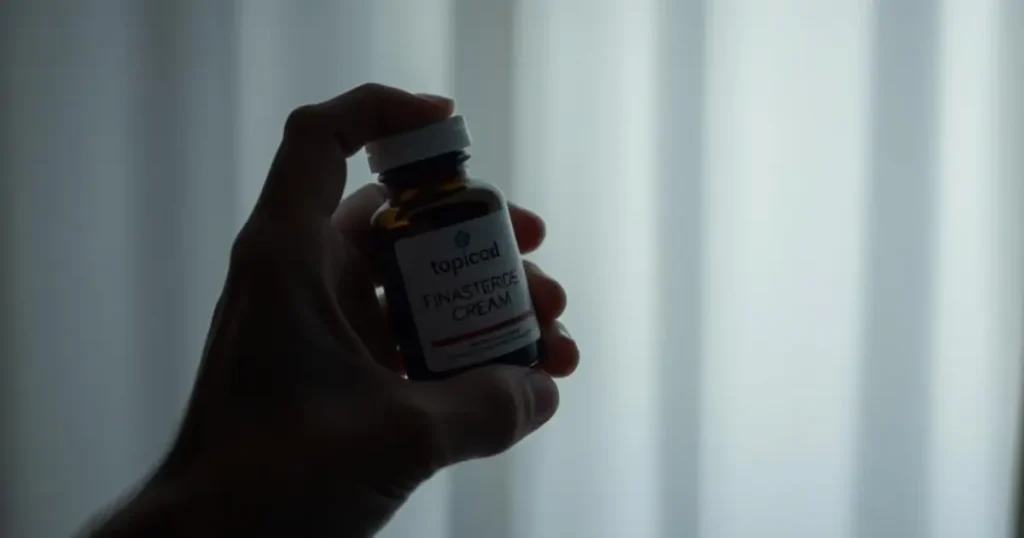
Executive Summary
- Topical Finasteride is a newer formulation designed to treat hair loss while minimizing systemic side effects like erectile dysfunction (ED).
- Compared to oral finasteride, topical versions show lower absorption in the bloodstream.
- Research suggests topical finasteride may reduce the risk of ED compared to oral forms, but more studies are needed.
- This article explores the mechanisms, benefits, risks, and myths surrounding topical finasteride and its impact on sexual health.
- Includes expert commentary, real data, side-by-side comparisons, and actionable advice for patients considering this option.
Introduction
Hair loss affects millions of men globally, and with it comes a host of emotional and psychological impacts. Among available treatments, finasteride—a DHT blocker—has been highly effective but not without controversy. While oral finasteride (Propecia) has proven benefits, it’s often linked to sexual side effects, particularly erectile dysfunction (ED). This has led to growing interest in topical finasteride, a formulation thought to minimize systemic exposure.
This article will provide a medically accurate, comprehensive look at topical finasteride, including its effectiveness, safety profile, and how it compares to oral versions in the context of ED. We’ll also address common myths, expert insights, and who should be cautious with this treatment.
What Is Topical Finasteride?
Definition and Mechanism of Action
Finasteride is a 5-alpha-reductase inhibitor, blocking the enzyme that converts testosterone to dihydrotestosterone (DHT)—a key factor in male pattern baldness.
Topical finasteride delivers the active ingredient directly to the scalp, aiming to reduce DHT in hair follicles without significantly lowering DHT levels throughout the body.
Why Erectile Dysfunction Is a Concern with Finasteride
The Link Between Finasteride and ED
Oral finasteride has been associated with ED, reduced libido, and ejaculatory dysfunction. The proposed mechanism is related to systemic DHT suppression, which plays a role in sexual health.
According to a 2016 study in the Journal of Sexual Medicine, some men reported persistent sexual side effects even after discontinuation.
Topical Finasteride vs Oral Finasteride
Table: Comparison of Topical vs Oral Finasteride
| Feature | Topical Finasteride | Oral Finasteride (1 mg/day) |
|---|---|---|
| Route of Administration | Applied to scalp | Taken orally |
| Systemic Absorption | Low to minimal | High |
| Risk of Erectile Dysfunction | Lower (based on current data) | Higher (5-15% in studies) |
| Onset of Action | Similar (3–6 months) | Similar (3–6 months) |
| Common Side Effects | Scalp irritation | ED, decreased libido |
| FDA Approval | Off-label | Approved for AGA |
Research Findings
- A 2021 study in Dermatologic Therapy found that topical finasteride reduced hair loss significantly while maintaining low plasma levels of the drug.
- Another 2020 review in Drugs in Dermatology concluded that topical forms had comparable efficacy with lower systemic exposure.
How Effective Is Topical Finasteride?
Topical Finasteride Effectiveness
Many users report positive outcomes within 3–6 months. The combination with minoxidil often enhances results.
- According to Tosti et al. (2021), the topical solution showed a 26% increase in hair density in 6 months.
- Combined therapies (minoxidil finasteride topical solution) often yield greater regrowth.
Common Side Effects of Topical FinasterideTopical Finasteride Side Effects vs Oral
Though side effects are generally milder, they may still include:
- Scalp irritation or redness
- Itching or flaking
- Rare reports of systemic effects like decreased libido
Compared to oral forms, the risk of sexual dysfunction is considerably lower, according to multiple peer-reviewed studies.
Expert Insight
“Topical finasteride represents a promising option for patients concerned about the sexual side effects of oral treatments. While data is still emerging, its lower systemic absorption suggests a reduced risk of ED. However, patients should always consult a qualified provider before starting treatment.”
— Dr. James O’Connor, MD, Dermatologist, American Hair Loss Association
Who Should Avoid Topical Finasteride?
Contraindications and Precautions
- Women who are or may become pregnant
- Individuals with known allergy to finasteride or topical excipients
- Men with existing sexual dysfunction concerns (should weigh risk-benefit)
- Users of oral finasteride—avoid double exposure
Myths vs Facts
| Myth | Fact |
| Topical finasteride causes the same side effects as oral | Not necessarily; systemic absorption is much lower. |
| It doesn’t work as well as oral finasteride | Studies show comparable hair regrowth outcomes. |
| It’s completely side-effect free | While milder, some users still report side effects. |
Frequently Asked Questions (FAQs)
1. Does topical finasteride cause erectile dysfunction?
Current evidence suggests a lower risk of ED compared to oral finasteride, but some rare cases are reported.
2. Can I use topical finasteride and minoxidil together?
Yes. Combination therapies are commonly used and may improve hair regrowth efficacy.
3. Where can I buy topical finasteride?
It is available through compounding pharmacies or online via prescription. Search “topical finasteride buy” for licensed sources.
4. Is topical finasteride FDA approved?
No. Topical use is off-label, though widely prescribed by dermatologists.
5. What are the signs that it’s working?
Reduced hair shedding and visible regrowth within 3–6 months are common signs.
Conclusion: Should You Be Concerned About Topical Finasteride and ED?
The risk of erectile dysfunction with topical finasteride appears significantly lower than with oral finasteride. Though not entirely risk-free, its targeted application allows for effective hair loss treatment with fewer systemic effects.
Patients concerned about ED should discuss the topical option with a knowledgeable healthcare provider. Personalized medical advice is key to finding the safest and most effective hair loss solution.
Final Advice
If you’re considering hair loss treatment but are worried about sexual side effects, topical finasteride may offer a safer alternative. Consult with a board-certified dermatologist or healthcare provider to determine the best plan tailored to your needs.
Call to Action: Ready to take the next step in managing hair loss without compromising your sexual health? Book a consultation with a Curomed expert today and get personalized guidance on the best treatment options for you.
References
- Tosti, A., Miteva, M., & Torres, F. (2021).
Topical finasteride in the treatment of androgenetic alopecia: efficacy and safety. Journal of the American Academy of Dermatology, 84(4), 964-965.
https://doi.org/10.1016/j.jaad.2020.11.056 - Caserini, M., Radicioni, M., Leuratti, C., Annoni, O., & Palmieri, R. (2014).
Pharmacokinetics of a new topical formulation of finasteride in healthy volunteers. British Journal of Clinical Pharmacology, 78(4), 906–913.
https://doi.org/10.1111/bcp.12397 - Rossi, A., Iorio, A., Scali, E., Fortuna, M. C., Caro, G., & Mari, E. (2018).
Finasteride 0.25% topical solution in the treatment of male androgenetic alopecia: a phase III, randomized, double-blind, placebo-controlled clinical trial. Dermatologic Therapy, 31(5), e12674.
https://doi.org/10.1111/dth.12674 - Shapiro, J., & Kaufman, K. D. (2003).
Use of finasteride in the treatment of men with androgenetic alopecia (male pattern hair loss). Journal of Investigative Dermatology Symposium Proceedings, 8(1), 20–23.
https://doi.org/10.1046/j.1523-1747.2003.12163.x - Irwig, M. S. (2012).
Persistent sexual side effects of finasteride: could they be permanent? Journal of Sexual Medicine, 9(11), 2927–2932.
https://doi.org/10.1111/j.1743-6109.2012.02846.x
